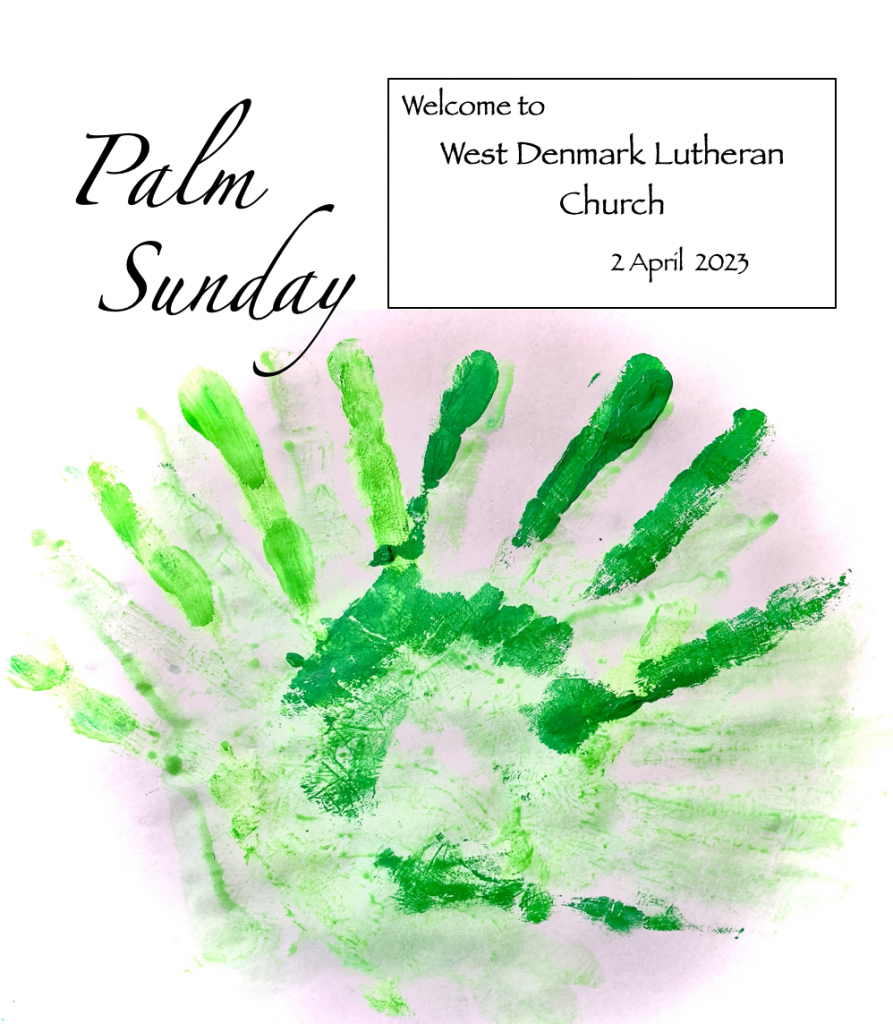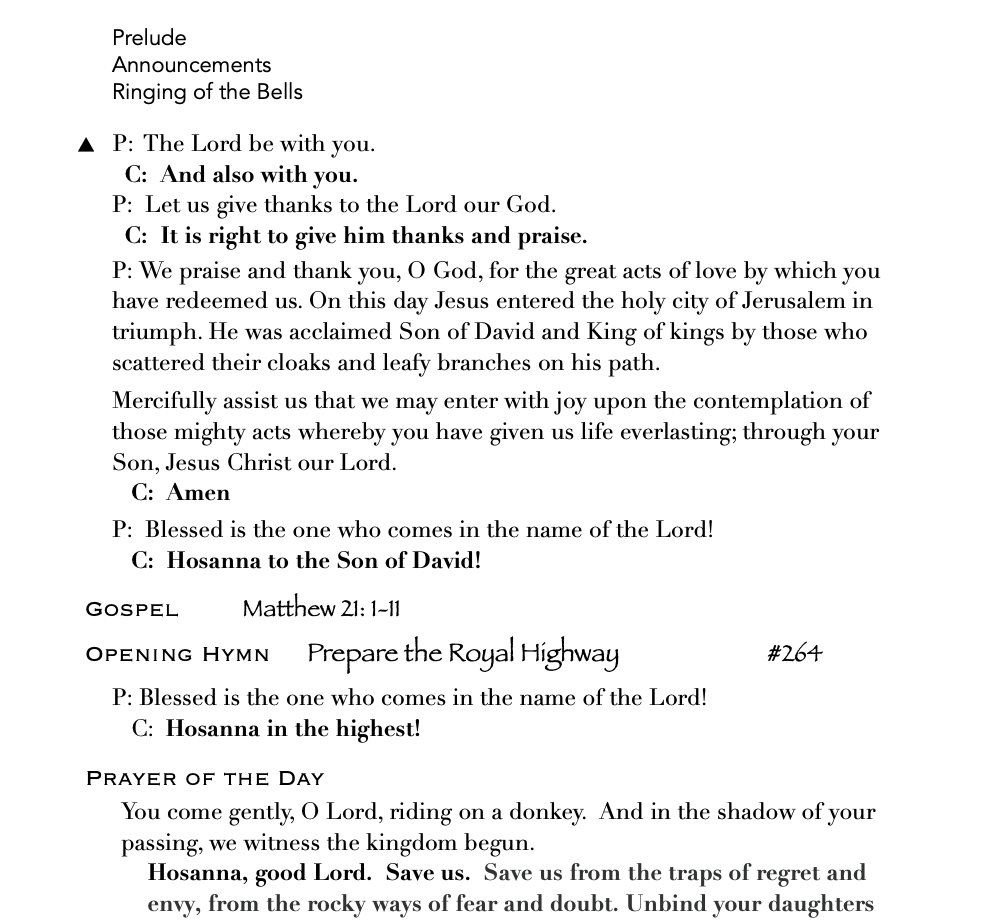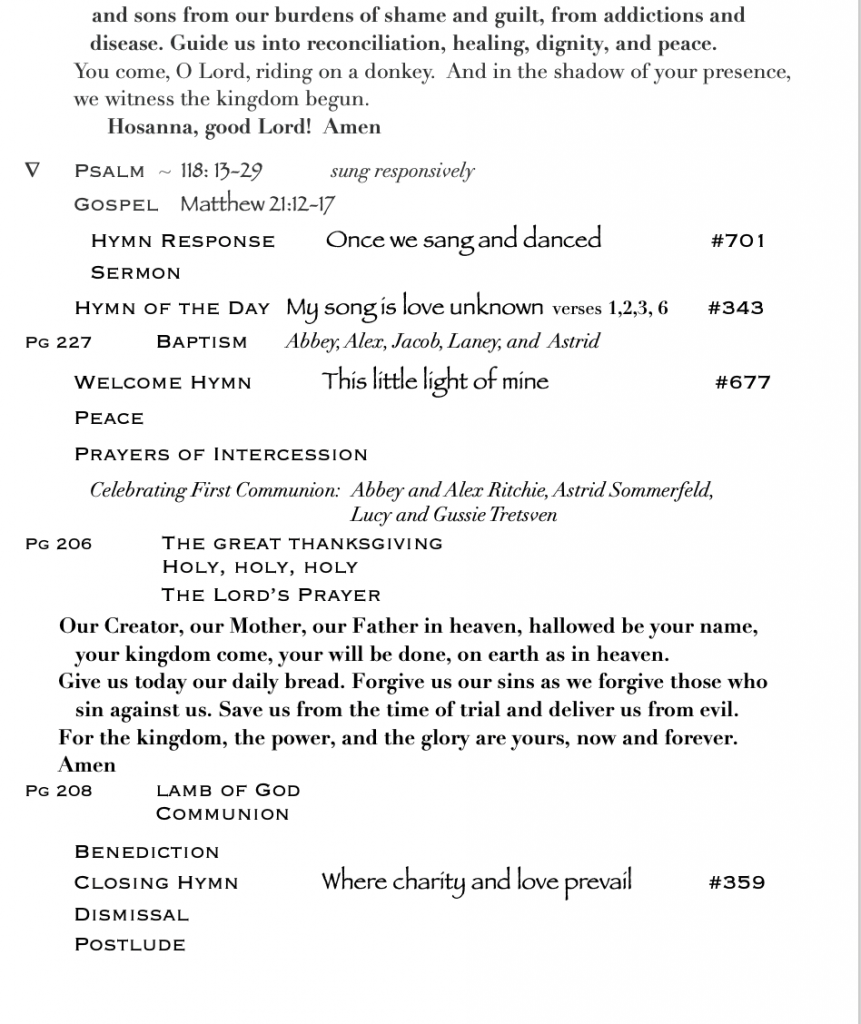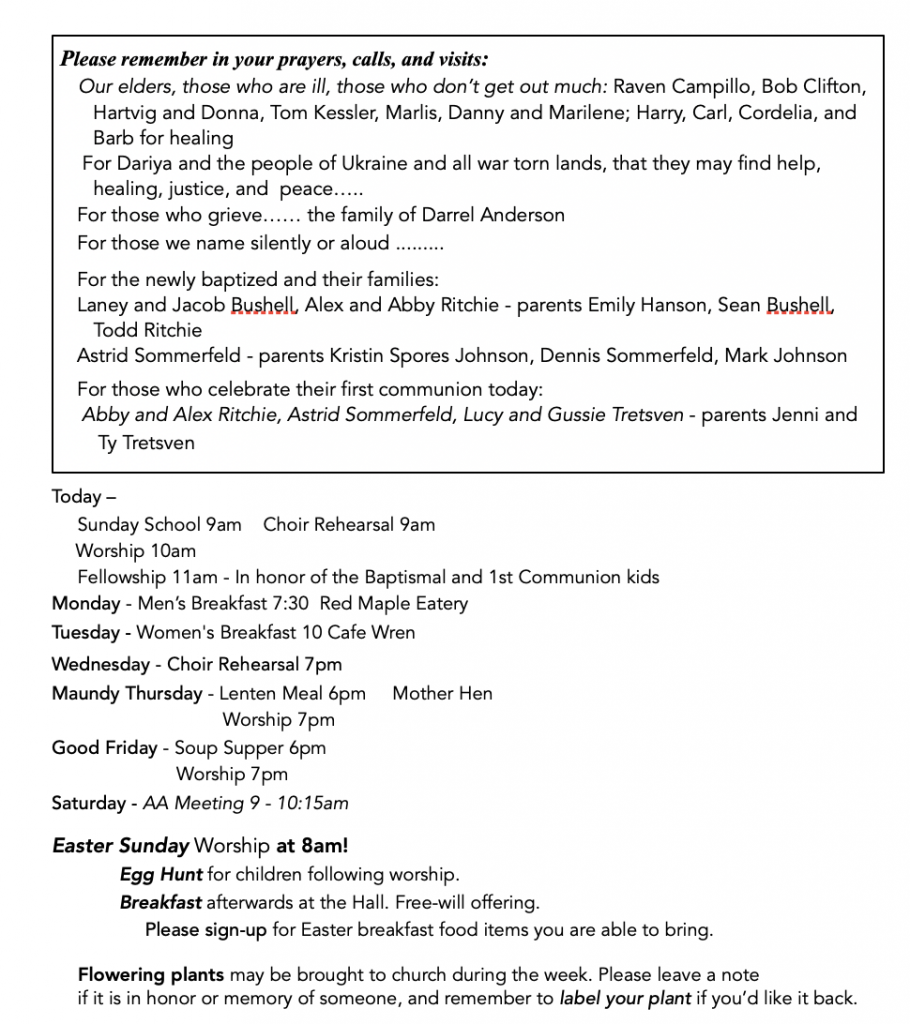Audio Recording



Matthew 21:1-17
When they had come near Jerusalem and had reached Bethphage, at the Mount of Olives, Jesus sent two disciples, saying to them, “Go into the village ahead of you, and immediately you will find a donkey tied, and a colt with her; untie them and bring them to me. If anyone says anything to you, just say this, “The Lord needs them.’ And he will send them immediately.”
This took place to fulfill what had been spoken through the prophet, saying, “Tell the daughter of Zion, Look, your king is coming to you, gentle, and mounted on a donkey, and on a colt, the foal of a donkey.” The disciples went and did as Jesus had directed them; they brought the donkey and the colt, and put their cloaks on them, and he sat on them. A very large crowd spread their cloaks on the road, and others cut branches from the trees and spread them on the road. The crowds that went ahead of him and that followed were shouting, “Hosanna to the Son of David! Blessed is the one who comes in the name of the Lord! Hosanna in the highest heaven!”
___________
“When he entered Jerusalem, the whole city was in turmoil, asking, “Who is this?” The crowds were saying, “This is the prophet Jesus from Nazareth in Galilee.” Then Jesus entered the temple and drove out all who were selling and buying in the temple, and he overturned the tables of the money changers and the seats of those who sold doves. He said to them, “It is written, “My house shall be called a house of prayer’; but you are making it a den of robbers.”
The blind and the lame came to him in the temple, and he cured them. But when the chief priests and the scribes saw the amazing things that he did, and heard the children crying out in the temple, “Hosanna to the Son of David,” they became angry and said to him, “Do you hear what these are saying?” Jesus said to them, “Yes; have you never read, “Out of the mouths of infants and nursing babies you have prepared praise for yourself’?”
He left them, went out of the city to Bethany, and spent the night there.”
The gospel of our Lord….thanks be to God.
I couldn’t get Palms this year. I thought I had ordered them in February from Eco-Palms, as in other years, but at some point I realized that I hadn’t gotten the usual follow-up email telling me about the delivery date. When I checked up on it, they said they had had computer issues and lost orders during a week or two in February and that, while they were very sorry, they were sold out. Storms, flooding and shipping issues have been a problem for their suppliers this year. By then it was too late to get them through other sources, so we are palm-less this year.
Which, naturally, got me thinking about the palms we do have, which lead me to create the bulletin cover. I would warn you that if you feel inclined to make green hand prints to remember that green is created from mixing yellow and blue together, and that blue pigment is difficult to remove.
This lack of palms to wave has lead to thinking about palms as in hands and not as trees. One of my favorite scripture images comes from Isaiah 49:
14 But Zion said, ‘The Lord has forsaken me, my Lord has forgotten me.’
And the prophet speaks for God saying: 15 “Can a woman forget her nursing-child, or show no compassion for the child of her womb? Even these may forget, yet I will not forget you.
16 See, I have inscribed you on the palms of my hands.”
I have inscribed you on the palm of my hands. Tattooing is prohibited in Leviticus 28, as is cutting gashes for scarring, so that isn’t what God has done. My daughter used to write memos to herself in the palms of her hands so she wouldn’t forget – and that’s how I imagine God’s palms, full of names and memos so that She will not forget, like the rainbow is a sign so that God will not forget the promise made to Noah. I take some amount of comfort that God seems to need aides to memory, memos to self.
This line of thought leads me to Palm reading and life lines, that forever, people have felt our futures were visible, discoverable, written into the palms of our hands. Maybe that’s how we are inscribed… in God’s life lines, crossed and curving, intersecting.
We are instructed to hold out our hands in blessing. When we bless something it is with palms down or facing out, but to hold our hands open, palms up, is to plead, to beg, to receive a blessing.
The people traveling to Jerusalem that day with Jesus were going for the Passover celebration. They were waving palms in festival celebration. We do that, too, in celebration – waving our palms at concerts or sporting events, or in church – although Lutherans tend not to do that. We tend not to do demonstrative actions in public. It’s not because of theology – it’s more a matter of temperament and reserve, but we are known for service. Lutheran World Service, World Hunger, Disaster Relief – these ‘hands’ of our church are very active in our country and in the world. Lutheran aid agencies are in Mississippi helping with tornado relief and in Poland helping with Ukrainian resettlement and aide. We’re still working in Malawi and Haiti.
“God’s work, our hands” has been a slogan of the ELCA (our national church body) for years, reflecting the quote of Teresa of Avila from the 1500’s, “Christ has no body now but yours. No hands, no feet on earth but yours. Yours are the eyes through which he looks compassion on this world. Yours are the feet with which he walks to do good. Yours are the hands through which he blesses all the world. Yours are the hands, yours are the feet, yours are the eyes, you are his body. Christ has no body now on earth but yours.”
What does it mean to be palm-less on Palm Sunday? Well, we aren’t.
We are celebrating Baptism and First Communion this morning. If you listen to the baptismal pledge, you will hear our walking orders for the Christian life – to pray, to learn, to act. To offer our hands in help and in blessing. In communion, we open our hands to receive the gift of Christ’s presence, his very body given for us, placed in our palms.
Jesus was on his way to Jerusalem and to his death. When he got to the temple, he upset the tables of moneychangers and merchants. I’ve read that, given the size of the temple and the temple market, it was likely a symbolic action of just a few tables, a local action and not clearing the whole market. That action seems to have grasped our visual attention, but it is what comes next that sealed his fate. “The blind and the lame came to him in the temple, and he cured them. When the chief priests and the scribes saw the amazing things that he did, and heard the children crying out in the temple, “Hosanna to the Son of David,” they became angry.” It wasn’t disrupting temple commerce, it was the power of his hands to heal, it was the power of God in his hands and words, it was the kids singing out Hosanna – hoshiannah – it means “save us.” It is both a word of praise and plea. That’s what made them so afraid that they had to stop him.
Entering Jerusalem – especially in this way, Jesus has cast his lot. Nothing is left now but to play it out. He has come to Jerusalem, the site of the temple, the holy place of ancient Israel, the city of his ancestor King David, the city that stones the prophets. He has come during Passover when the blood of a lamb without blemish or fault is shed, an offering of sacrifice to mark the people of God.
Who is this poignant mix of savior and martyr? Who is this one hailed as messiah by children and happy crowds anticipating a celebration? Who is this, who, though clearly not a king, yet rides into the city like a king? Who is this whose devoted followers soon turn on him, as the disciples disperse, his friend denies, and the crowds accuse? Who is this who is tried by both religious and political elite and found, not guilty, but innocently threatening, an enemy to the establishment? Who is this who is dragged through the streets of Jerusalem and hauled to the execution grounds? Who is this who is hung on a cross abandoned and forsaken?
There is nothing about Jesus — his entry into Jerusalem and the temple, his biting critique of authority, his brutal and lonely death — nothing that would inspire those who saw him to feel anything but pity and uncertainty and dread. He comes in power but also in weakness, in vulnerability, in mercy not in judgment, in love not in vengeance. Nothing about him conforms to the expectations and experiences of a world that believes above all that bullies rule, that might makes right, or, at the very least, that might wins.
And yet, Christians have claimed ever since Jesus’ death that the fatal flaw in this logic of the world is that the way of the world, the cycle of power and influence and might, leads only to violence and death. There is no hope in the right of might, no possibility of redemption through violence. As Martin Luther King Jr., once said, “Darkness cannot drive out darkness; only light can do that. Hatred cannot drive out hate; only love can do that.”
This is Jesus, the One we confess did not die in order to make it possible for God to love us, but rather the one whose death demonstrates that God already does love us, and that God’s love is our only hope.
This is Jesus, the one we claim each week as messiah and Lord, source of life and healing.
This is Jesus, the paradigm of God’s action in the world, whose story comes to a climax this week in order that our story might begin anew and end with the promise of a new and different tomorrow.
Week after week, in song and word and prayer and acted out in our lives for others we follow this Jesus, the prophet of Nazareth, the gift and plea and sign, who is also Christ the Lord, the son of God….
Instead of waving palm branches, may we offer our palms in thanksgiving and praise and hope and help for a world that needs the Christ in us to show.
